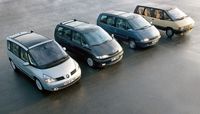Renault Celebrates Espace Silver Jubilee - Spanning Four Generations of the First MPV
MAPLE CROSS, UNITED KINGDOM – June 5, 2009: Summer marks the twenty-fifth anniversary of the Renault Espace first going on sale. Sales of the groundbreaking vehicle, which started the MPV revolution back in the early Eighties and has had four distinct generations, have now reached almost 1.2 million since its launch in 1984, 80,000 of which are in the UK.
Originally conceived by Renault and its partner, Matra, the first Espace appeared in 1984 and was initially greeted with a combination of intrigue and scepticism - nothing like Espace had ever been seen before. Flying in the face of accepted wisdom, the Espace epitomised Renault’s desire to push the boundaries of conventional design and create a car which met the changing needs of a rapidly evolving society.
With each successive version, Renault brought additional enhancements in terms of safety, driving pleasure and travelling comfort, to the point where today’s latest model is more than a match for a ‘conventional’ executive car.
Espace’s roots can be traced back to late November 1979 when a prototype (P16) was trialled based on Renault's plans for a grand-touring saloon with a flexible interior and individual seats, meanwhile Matra had plans for a similar vehicle inspired by the mini-van market in America but with bench seats. Espace was conceived on 15th December 1982 when Matra and Renault joined forces on a second prototype codenamed P23. Renault took charge of product definition, interior and exterior design, powertrains, promotion and sales while Matra handled vehicle development and production.
Jacques Cheinisse, head of Renault's upmarket product range at the time, drew up the specifications that would define the key features of the Renault MPV concept: uncluttered flat floor for front-to-back mobility, five or seven independent seats (with two front swivelling seats), and bodywork made from composite material to keep vehicle weight low.
Out of the World
The name Espace (the French word for
"space", in both its usual senses) fit the vehicle perfectly, and
advertising material made much of the opportunities for wordplay, with
frequent references to the vehicle's "out of this world" qualities.
Espace 1 was unveiled to the Press in April 1984 as a 110hp 2.0 litre petrol model, this first version being joined the end of 1984 with an 88hp turbo-charged diesel model. On sale in France from July 1984, sales at the start were slow as people struggled to appreciate the look of a high roof ‘one box’ car. Sales climbed in 1985, and demand soon outstripped production at the Matra Romorantin plant, leading to the need for extra manufacturing capacity at the Renault Dieppe plant in 1987.
With sales topping 192,000, the first-generation Espace underwent a major facelift in January 1988; all versions had fresh frontal styling, and a Quadra version was introduced with four-wheel drive. Release of Espace II at the Geneva Motor Show in 1991 marked Renault's strong determination to push its MPV concept forward even further. Modularity was upgraded with the introduction of innovative floor rails for the second and third row seat fixing, a more sophisticated climate control system was introduced, and the A pillars were slimmed down by 40% to improve visibility.
In 1994, at the European Grand Prix, Renault showcased the Espace F1, a remarkable demonstration car powered by the 3.5-litre, 820hp V10 engine that had excelled in the previous year's Formula 1 World Championship. Espace II production from 1991 to 1996 reached 316,518, with total production across the first two generations topping the half-million mark in July 1996.
Grand Espace arrives
The third-generation Espace, unveiled in
October 1996, brought an upmarket shift to keep ahead of the competition.
The dashboard featured a central digital display for improved legibility
and, to meet the needs of customers looking for an even more spacious
vehicle, Renault launched a longer wheelbase version (27 cm longer) in
January 1998, called Grand Espace. By the end of 2001, Espace III held an
18.5% share of the MPV market. Overall production of this third-generation
Espace topped 365,200 units.
The latest generation, Espace and Grand Espace IV, went on sale in 2003. Consolidating the model’s upmarket positioning and enhancing the driving pleasure and laidback luxury, the Espace’s V6 petrol and diesel engines remain unique in this market sector. The optional sunroof remains one of the largest available, significantly adding to the ambiance inside.
Espace IV leads its field in comfort, performance and safety. It was the first in class to achieve the maximum five-star rating in the Euro NCAP tests, thanks to a range of advanced safety features, such as seats with integrated seatbelts in all second- and third-row places.
With Espace, Renault created a whole new vehicle concept, which was successfully carried over to the original Twingo in 1992, ScÚnic in 1996, and Modus in 2004.
The Renault Espace has been the leading vehicle of its kind since inception, and, after 25 years, it shows absolutely no sign of relinquishing its supremacy in the increasingly competitive MPV market.



